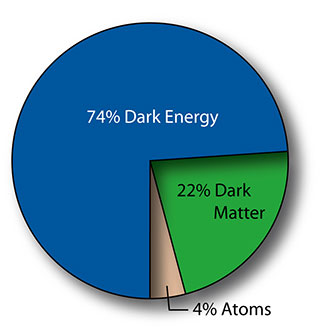|
|
 This pie chart shows the make-up of the Universe today, as derived from fits to the "ripples" in the cosmic microwave background and other data. Only about 10% of the "ordinary atoms" is actually contained in the stars and luminous gas that we see: the Universe is actually a very dark place. Image from the WMAP website; credit: NASA/WMAP Science Team.
This pie chart shows the make-up of the Universe today, as derived from fits to the "ripples" in the cosmic microwave background and other data. Only about 10% of the "ordinary atoms" is actually contained in the stars and luminous gas that we see: the Universe is actually a very dark place. Image from the WMAP website; credit: NASA/WMAP Science Team.
|
Summary of Lecture 12 – Echoes of the Big Bang
- Principal observational evidence for the Big Bang:
- the universe is expanding according to Hubble's law:
- suggests (does not prove, cf. Steady State)
that the universe was once much smaller and denser (and
therefore hotter);
- there is a nearly isotropic cosmic microwave
background with an exact blackbody spectrum:
- can be explained as photons released approximately 380,000
years after the Big Bang, when electrons combined with nuclei
to form neutral atoms, and the universe became transparent;
- blackbody spectrum shows that the Universe was once hot,
dense and opaque (since transparent sources don't
produce blackbody spectra);
- original 3000 K temperature reduced to 2.7 K by expansion of
universe (redshifting photons);
- very strong evidence for Hot Big Bang –
other models, such as Steady State, do not have the hot,
dense early universe needed to make a blackbody spectrum;
- galaxies look different at large redshift:
- evidence that the universe is evolving (evidence against
Steady State);
- can help to determine model parameters (e.g. any model which
says that galaxies should form at a time corresponding to
redshift=1 is clearly wrong, since galaxies have been
observed with redshifts >5);
- the abundances of the light isotopes deuterium (or
hydrogen-2), helium-4 and lithium-7:
- measured by spectral analysis of old objects;
- results agree well with predictions of big bang
nucleosynthesis;
- further evidence for hot Big Bang, and strong
support for the accuracy of our understanding of the early
universe and its evolution;
- the cosmic microwave background exhibits tiny temperature
variations:
- fitting these to predictions can determine parameters of
Big Bang model (see below);
- results agree well with expectations from Hot
Big Bang plus inflation, with derived parameters
consistent with other data;
- further evidence for hot Big Bang, and support
for inflation as mechanism for achieving flatness and
uniformity.
- Vital statistics of the universe:
- Hubble's constant (H0) – determines
expansion rate of universe, and thus its age;
- main difficulty is distance measurement
(redshifts are easy!);
- HST result: 72 ± 8 km s-1
Mpc-1
WMAP result: 71.0 ± 2.5 km s-1
Mpc-1
recent review: 73 ± 4 km s-1
Mpc-1
- curvature (k) – determines geometry of
universe;
- inflation predicts k = 0 (universe is flat),
i.e. Ωtotal = 1;
- best information comes from cosmic microwave background;
- WMAP result: 0.99 < Ωtotal <
1.01 (combining WMAP with other data);
- density as a fraction of critical density
(Ω):
- Ω is made up of many different components measured
in different ways:
- calculate stellar masses from mass-luminosity relation, and add
them up –
Ωstars ≅ 0.004;
- fit abundances of deuterium and helium-4 –
Ωatoms ≅ 0.04;
- calculate galaxy masses from their gravitational forces
(rotation curves), and add them up –
Ωgalaxies ≅ 0.1;
- calculate masses of galaxy clusters (from motion of galaxies,
X-ray emission from cluster gas, or gravitational lensing)
–
Ωclusters ≅ 0.3;
- analyse fluctuations in microwave background –
Ωmatter = 0.27 ± 0.02;
- conclusion: matter accounts for about 30% of the
critical density, but (1) only about 1/7 of this is made
up of ordinary atoms and (2) even 90% of the ordinary atoms
are not in stars (nearly 99% of the matter in the universe
is non-luminous);
- cosmological constant as a fraction of critical
density (ΩΛ):
- Type Ia supernovae show that expansion is
accelerating, not slowing down as expected;
- combination of supernova data and microwave background gives
ΩΛ
= 0.73 ± 0.02;
- physical interpretation of Λ is that it represents the
(quantum mechanical) energy of empty space;
- nobody currently understands why Λ has its present
value, or how it might evolve in future.
- Our current view of the universe, past, present and future:
- the universe is currently expanding and cooling from an initial Hot
Big Bang which took place about 13.7 billion years ago;
- a tiny fraction of a second after the big bang, the universe
underwent a brief period of rapid (exponential) expansion –
inflation – which resulted in an extremely isotropic and flat
visible universe, with small variations from quantum fluctuations;
- the total density of the universe is equal to the critical density
(the universe is flat) and has contributions from both matter and the
cosmological constant,
roughly ¼ matter and ¾ Λ;
- of the matter component, about 85% is not ordinary atoms, but
as yet unidentified non-baryonic dark matter;
- although the universe is flat, because Λ > 0 the expansion
is not decreasing towards zero but instead is accelerating –
the unvierse will expand forever at an ever-increasing rate
(unless we are wrong about the "cosmological constant" being
constant).
Web links
Go back to main page
Go on to Summary for Lecture 13
|
Hicks Building, Hounsfield Road, Sheffield S3 7RH, UK
|